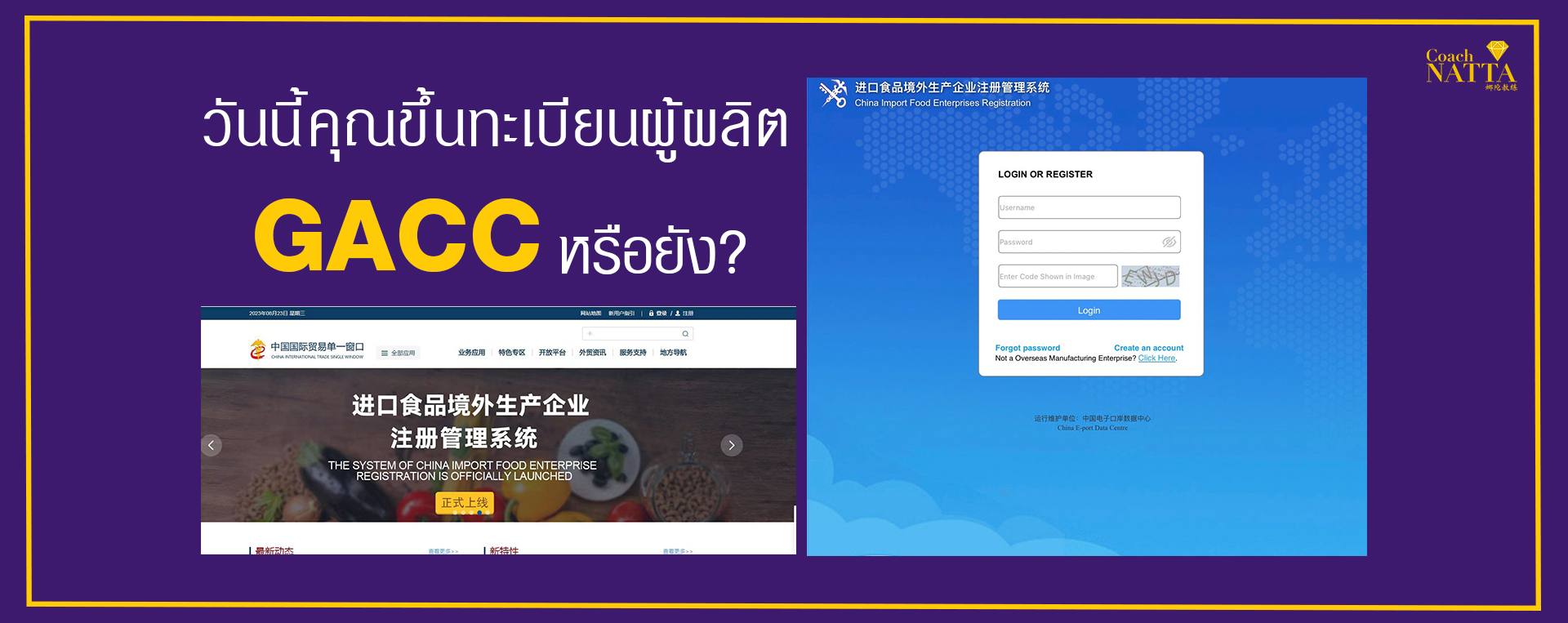
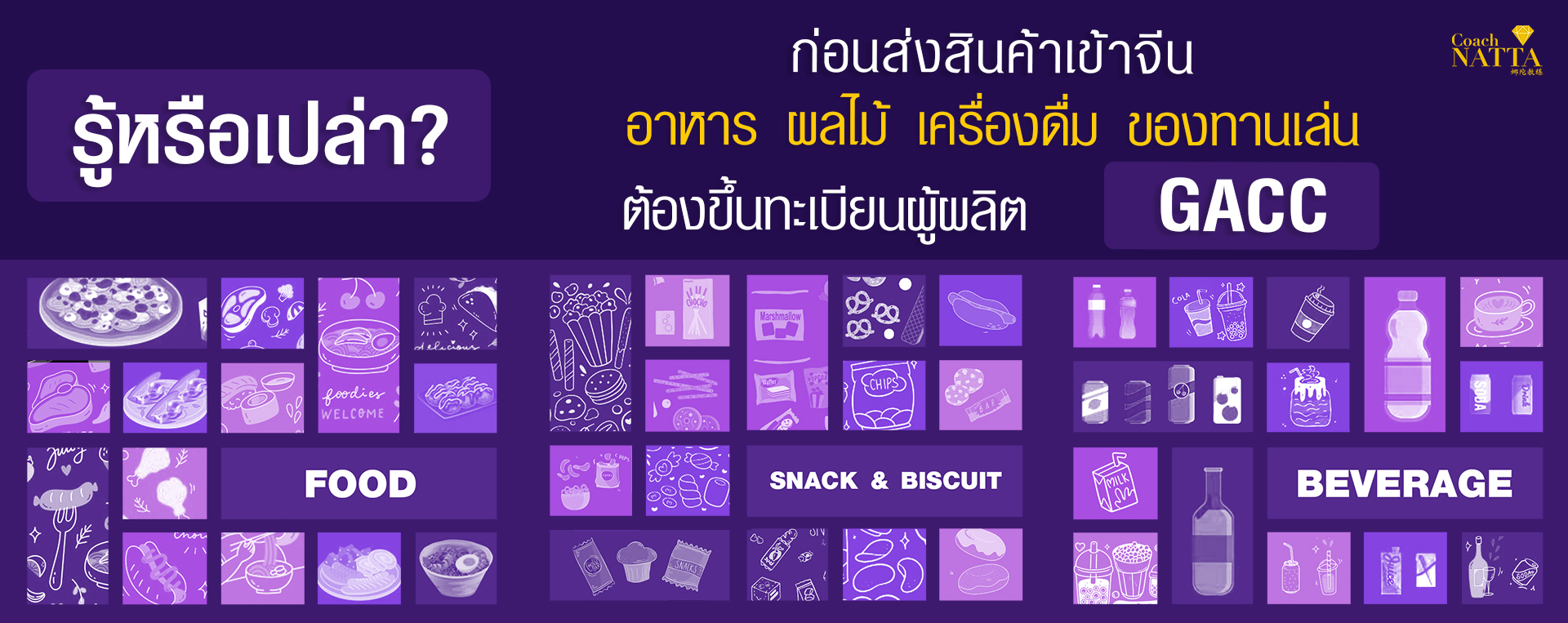
GACC คือ การขึ้นทะเบียนผู้ผลิตสินค้าอาหารส่งออกไปจีน ตามระเบียบฉบับใหม่ของจีน (ระเบียบ 248-249)
ระเบียบใหม่ของจีนในการนำเข้าสินค้าอาหาร ประกาศโดยสำนักงานศุลกากรแห่งสาธารณรัฐประชาชนจีน (General Administration of Customs of the People's Republic China: GACC)
· ระเบียบฉบับที่ 248 ว่าด้วยการขึ้นทะเบียนผู้ผลิตอาหารนำเข้าจากต่างประเทศ (Regulations on the Registration and Administration of Overseas Producers of Imported Food: Decree 248)
· ระเบียบฉบับที่ 249 ว่าด้วยมาตรการความปลอดภัยสำหรับอาหารนำเข้าและส่งออก (Administrative Measures on Import and Export Food Safety: Decree 249)
สำนักงานศุลกากรจีน (GACC) ได้มีการออกประกาศระเบียบว่าด้วยการขึ้นทะเบียนผู้ผลิตอาหารนำเข้าจากต่างประเทศ โดยกำหนดให้ ผู้ผลิต ผู้แปรรูป และสถานที่เก็บสินค้าที่ผลิตอาหาร ส่งออกมายังจีน จะต้องมีการขึ้นทะเบียนผู้ผลิตก่อน จึงจะสามารถส่งออกไปจีนได้ โดยมีผลบังคับใช้ตั้งแต่วันที่ 1 มกราคม 2565 เป็นต้นมา โดยระเบียบดังกล่าวนำมาแทนที่กฎระเบียบ Decree 145 ว่าด้วยการขึ้นทะเบียนผู้ผลิตอาหารในต่างประเทศของสำนักงานควบคุมคุณภาพ ตรวจสอบและกักกันโรคแห่งประเทศจีน (The General Administrationof Quality Supervision, Inspection and Quarantine: AQSIQ Decree 145) ที่เดิมระบุเฉพาะสินค้าเสี่ยงสูงบางรายการ (เนื้อสัตว์ ผลิตภัณฑ์นม สินค้าประมง และรังนก) ต้องขึ้นทะเบียนดังกล่าว
ระเบียบดังกล่าวกำหนดให้ผู้ผลิตอาหารจากต่างประเทศต้องมีการขึ้นทะเบียนกับหน่วยงาน GACC ก่อนการ ส่งออกไปยังจีน โดยแบ่งสินค้าเป็น 2 กลุ่ม ได้แก่
1) กลุ่มสินค้าที่ต้องขึ้นทะเบียนผ่านหน่วยงานกำกับดูแล (Competent Authority: CA) สำหรับกลุ่มสินค้า 18 กลุ่มสินค้า และ
2) กลุ่มสินค้าที่ขึ้นทะเบียนโดยตรงกับ GACC
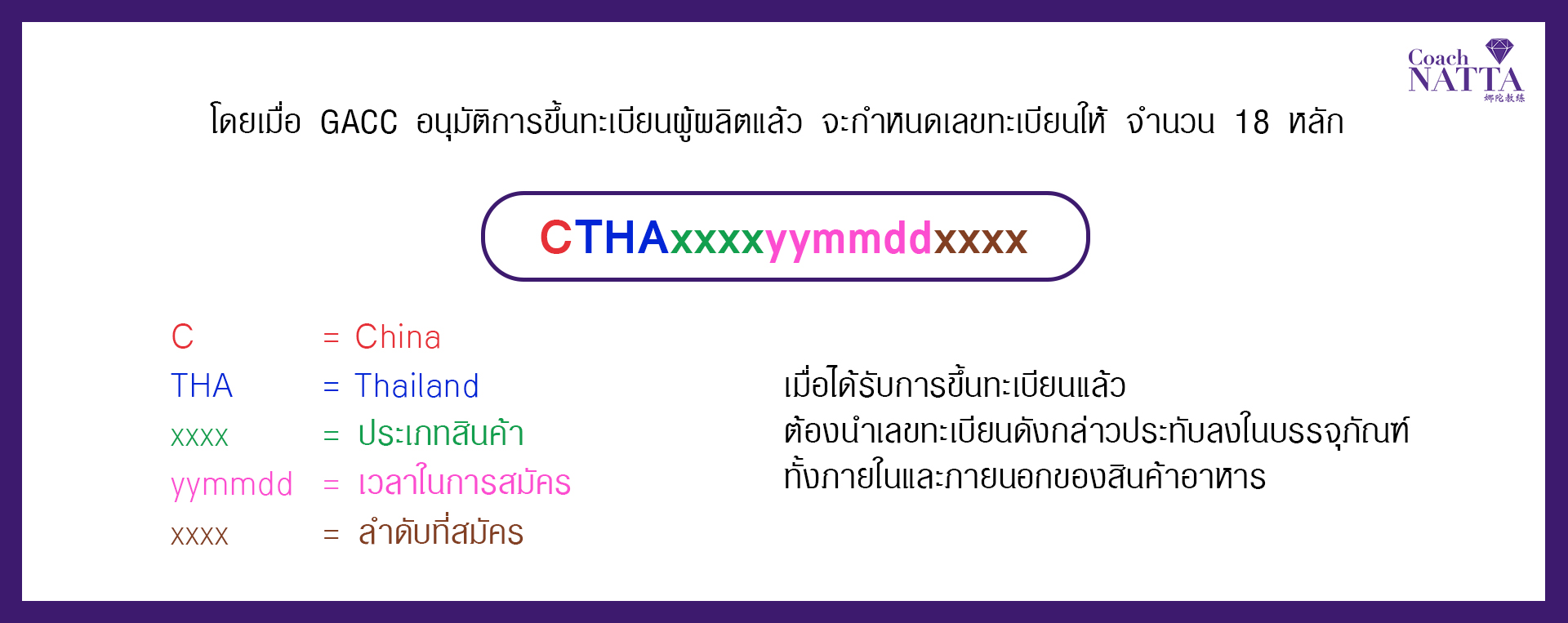
ABOUT GACC
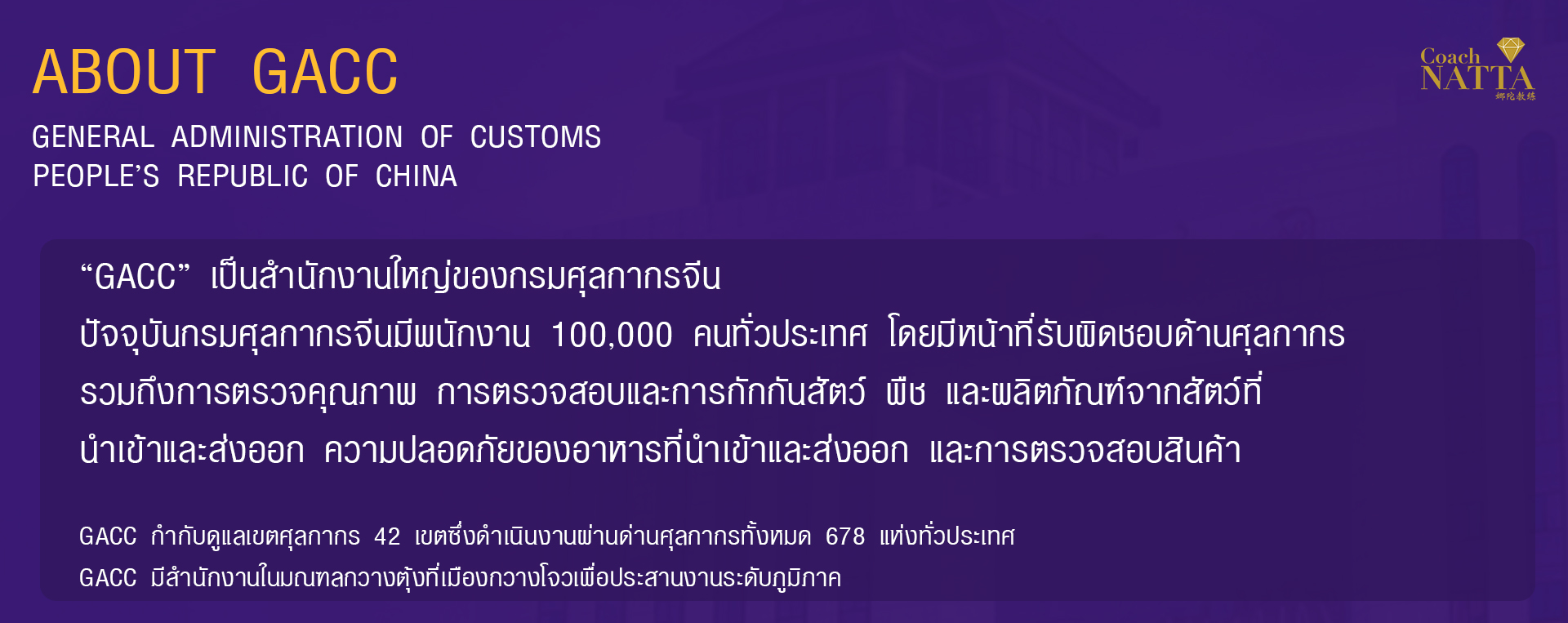
GENERAL ADMINISTRATION OF CUSTOMS PEOPLE’S REPUBLIC OF CHINA
“GACC” เป็นสำนักงานใหญ่ของกรมศุลกากรจีน ปัจจุบันกรมศุลกากรจีนมีพนักงาน 100,000 คนทั่วประเทศ โดยมีหน้าที่รับผิดชอบด้านศุลกากร รวมถึงการตรวจคุณภาพ การตรวจสอบและการกักกันสัตว์ พืช และผลิตภัณฑ์จากสัตว์ที่ นำเข้าและส่งออก ความปลอดภัยของอาหารที่นำเข้าและส่งออก และการตรวจสอบสินค้า
GACC กำกับดูแลเขตศุลกากร 42 เขตซึ่งดำเนินงานผ่านด่านศุลกากรทั้งหมด 678 แห่งทั่วประเทศ
GACC มีสำนักงานในมณฑลกวางตุ้งที่เมืองกวางโจวเพื่อประสานงานระดับภูมิภาค
ผลบังคับใช้การขึ้นทะเบียน
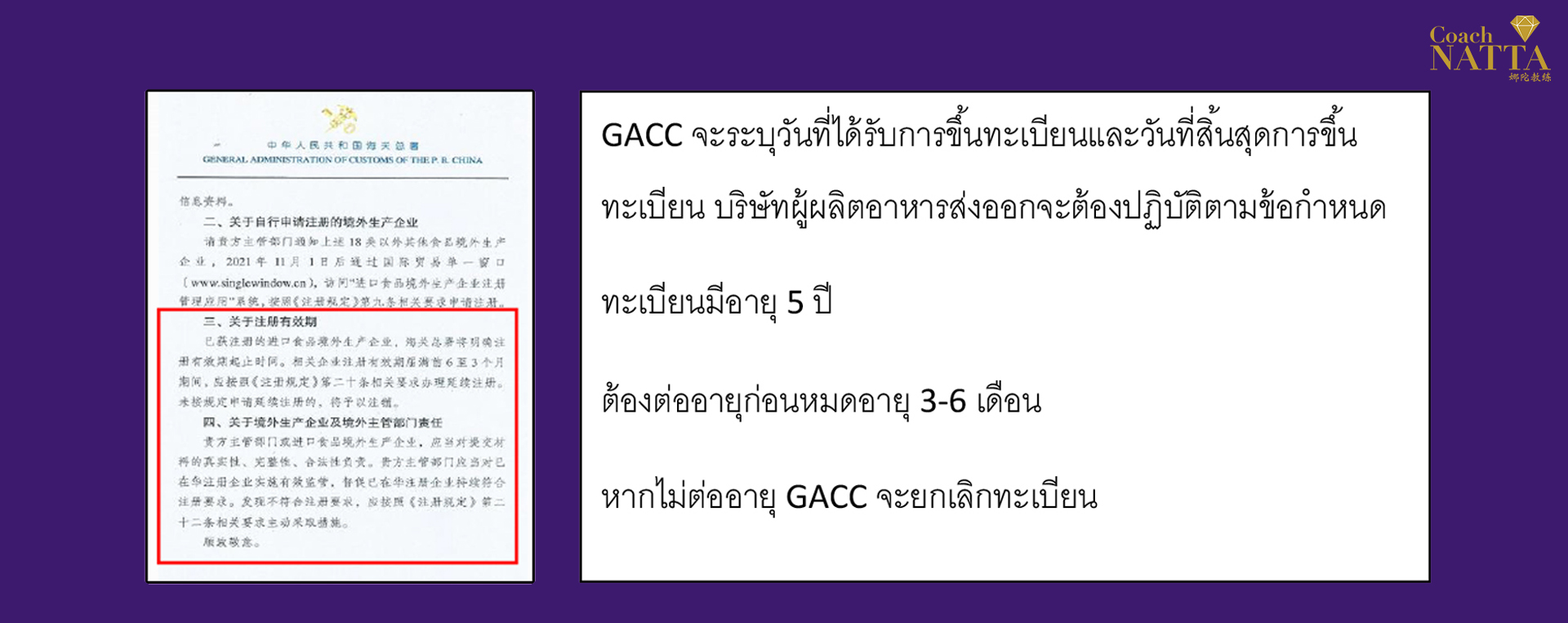
นิยามของกลุ่มสินค้า 18 รายการ
ที่ต้องขึ้นทะเบียนผ่านหน่วยงานรับผิดชอบของประเทศผู้ส่งออก พร้อมช่องทางการติดต่อ
| ที่ | กลุ่มสินค้า | คำนิยาม (Definition) | หน่วยงานรับผิดชอบ |
1. | เนื้อสัตว์และผลิตภัณฑ์จากเนื้อสัตว์ (meat and meat products) | Any edible part of slaughtered animals1 Including body, organ, byproduct, and products produced from the above materials, exclusive of tinned food. | กรมปศุสัตว์ |
2. | ผลิตภัณฑ์ไส้บรรจุไส้กรอก (sausage casing) | It refers to animal tissues that are salted or dried on the retained parts by using g organs such as small intestine, large intestine and bladder of healthy livestock k, after special processing such as scraping and de-oiling, and is the casing for sausage. | กรมปศุสัตว์ |
3. | ผลิตภัณฑ์สัตว์น้ำ (aquatic products) ไม่ครอบคลุมถึงสัตว์น้ำมีชีวิต (living aquatic animals) | Edible aquatic animal/plant products and products made thereof1 Aquatic animal products and products made from aquatic animals, including jelly fish, mollusk, crustacean, echinoderm, cephalochorda, fish, amphibious, reptile, aquatic mammal; ocean plants and products made from the ocean plants, such as seaweed. The catalogue does not include live aquatic animals, plants and animal breeding material. | กรมประมง |
4. | ผลิตภัณฑ์นม (dairy products) | Dairy products include raw milk and milk products. Raw milk refers to natural milk without any change of component that is milked from udders of healthy dairy stocks that comply with relevant regulations by Chinese government. Colostrums, milk produced during antibiotics using period and withdrawal period, and alterative milk shall not be used as raw milk. Dairy products refer to foods use milk (including raw milk, reconstituted milk or other sterilized liquid milk) as main ingredient1 - Sterilized milk Fermented milk (yogurt, flavor fermented) milk powder (skimmed milk, formulated milk, nutrition fortified formulated milk, etc.) butter (cream) condensed milk cheese whey powder Dairy based formula foods for infants and young children others (lactose, casein,…) | กรมปศุสัตว์ |
5. | รังนกและผลิตภัณฑ์จากรังนก (birdnests and bird nest products) | Cubilose and its products formed by salivary secretions of swallow, including aerodramus fuciphogu and aerodramus maximus, with dirt and feather removed and suitable for human consumption1 | กรมปศุสัตว์ |
6. | ผลิตภัณฑ์จากผึ้ง (bee products) | Natural sweet substances made from nectar, secretions or honeydew of plant s collected by honeys and mixed with their own secretions, as well as edible s ubstances formed naturally or made by special techniques during reproductio n and reproduction, including royal jelly, royal jelly powder, honey pollen, roy al jelly freeze-dried powder, etc. | กรมปศุสัตว์ |
7. | ไข่และผลิตภัณฑ์จากไข่ (eggs and egg products) | Egg products include: (1) liquid egg products: egg products made from fresh eggs after shelling and processing, such as whole egg liquid, egg yolk liquid and protein liquid; (2) Dried egg products: egg products made from fresh eggs by shelling, processing, desugaring, drying and other processes, such as whole egg powder, egg yolk powder and protein powder; (3) Frozen egg products: egg products made from fresh eggs by shelling, processing and freezing, such as frozen whole eggs, frozen egg yolk, ice protein, etc; (4) Remanufactured egg: egg products processed by different processes such as salt, alkali, distiller's grains and brine with or without auxiliary materials, such as preserved egg, salted egg, salted egg yolk and etc. | กรมปศุสัตว์ |
8. | น้ำมันและไขมันสำหรับการบริโภค (edible oils and fats) | edible fat refers to the vegetable oil made from edible vegetable oil for processing or consumption, and single products or mixtures of vegetable fat processed by one or more methods of refining and fractionation. Edible oil refers to the seeds of oil plants used for extracting edible vegetable oil, mainly including peanut and sesame for oil. | กรมวิชาการเกษตร |
9. | ผลิตภัณฑ์จากข้าวสาลีสำเร็จรูป (stuff pastry products) | refers to cooked or uncooked frozen products made with various raw materials as fillings and wheat flour as skins, such as steamed stuffed buns, jiaozi or pies. | ประสานงานกับหน่วยงานใด - กรมปศุสัตว์ (หากมีเนื้อสัตว์เป็นองค์ประกอบ) - กรมประมง (หากมีสัตว์น้ำเป็นองค์ประกอบหลักของไส้) |
10. | เมล็ดธัญพืชสำหรับการบริโภค (edible grains) | refers to the seeds, roots and tuber products of cultivated plants such as cereals and potatoes, mainly including edible products of gramineous herbaceous seeds after rough processing, such as rice, oats and sorghum. | กรมวิชาการเกษตร |
11. | ผลิตภัณฑ์เมล็ดธัญพืชบดและมอลต์ เพื่อการอุตสาหกรรม (milled grain industry products and malt) | refer to fine powdery products in which seeds, roots and tubers of cultivated plants such as cereals, potatoes, fruits and nuts are ground and screened for edible powder, or malt products formed after hydrolysis processing. | กรมวิชาการเกษตร |
12. | ผักสดและผักอบแห้ง (fresh and dehydrated vegetables) และถั่วอบแห้ง (dried beans) | refer to fresh vegetables or dried vegetable products processed by fresh- keeping, dehydration, drying and other drying processes and dried beans. | กรมวิชาการเกษตร |
13. | เครื่องปรุงรส (condiments/seasoning) | refer to natural plant products such as plant fruits, seeds, flowers, roots, stems, leaves, skins or whole plants, which can be used directly with the functions of fragrant, flavoring and seasoning. | กรมวิชาการเกษตร |
14. | ถั่วเปลือกแข็งและเมล็ดพืช (nuts and seeds) | nuts refer to the seeds of woody plants with hard shells, including walnuts, chestnuts, apricot kernels, almond kernels, pecans, pistachios, torreya grandis, Hawaiian fruits and pine seeds. Seeds refer to the seeds of melons, fruits, vegetables and other plants, including watermelon seeds and pumpkin seeds. | กรมวิชาการเกษตร |
15. | ผลไม้แห้ง (dried fruits) | refer to the dried fruit products made from fresh fruits by sun drying, drying and other dehydration processes. | กรมวิชาการเกษตร |
16. | กาแฟและเมล็ดโกโก้ที่ยังไม่ผ่านการคั่ว (unroasted coffee beans and cocoa beans) | unroasted coffee beans and cocoa beans. | กรมวิชาการเกษตร |
17. | อาหารสำหรับวัตถุประสงค์พิเศษ (food for special dietary purposes) | (1) Soybased infant formula: refers to soy and soy protein products as the main raw material, adding the right amount of vitamins, minerals and / or other ingredients, using only physical methods of production and processing made suitable for normal infants and young children to eat liquid or powder products. (2) Special medical use formula, in order to meet the eating restrictions, digestive and absorption disorders, metabolic disorders or specific disease states of people with special needs for nutrients or diet, specially processed and formulated formula. Such products must be under the guidance of a doctor or clinical nutritionist, eaten alone or in conjunction with other foods. | สำนักงานคณะกรรมการอาหาร และยา |
18. | อาหารเพื่อสุขภาพ (Health foods) | claim and have a specific health function or to supplement vitamins, minerals for the purpose of food. That is, suitable for consumption by a specific group of people, has the function of regulating the body, not for the purpose of treating disease, and does not produce any acute, subacute or chronic harm to the human body food. | สำนักงานคณะกรรมการอาหาร และยา |
ประสานหน่วยงานรับผิดชอบตามประเภทกลุ่มสินค้าตามระเบียบฉบับที่ 248 เพื่อขอรับการขึ้นทะเบียน
สินค้าพืช
กองพัฒนาระบบและรับรองมาตรฐานสินค้าพืช (กมพ.) กรมวิชาการเกษตร ทางอีเมลล์ qpsig@yahoo.co.th หรือ โทรศัพท์ 02-940-7422, 02-940-6464
สินค้าปศุสัตว์
สำนักพัฒนาระบบและรับรองมาตรฐานสินค้าปศุสัตว์ (สพส.) กรมปศุสัตว์ โทรศัพท์ 02-653-4444 ต่อ 3134, 3120 ทางอีเมลล์ inspection_blsc@dld.go.th
สินค้าประมง
กลุ่มรับรองคุณภาพสินค้าประมง กรมประมง โทรศัพท์ 02-558-0150 ต่อ 13403 หรือ 13504
ทางอีเมลล์ supindac@dof.mail.go.th, passarapak@hotmail.com หรือ passarapa.k@dof.mail.go.th สำนักงานคณะกรรมการอาหารและยา (อย.)
กองอาหาร สำนักงานคณะกรรมการอาหารและยา (อย.) โทรศัพท์ 02-590-7185 หรือทางอีเมลล์ contactfooddivision@gmail.com
ผลงานการยื่นจดทะเบียน GACC ดำเนินการรวดเร็ว
เริ่มยื่นจดทะเบียนวันที่ 27/06/2566
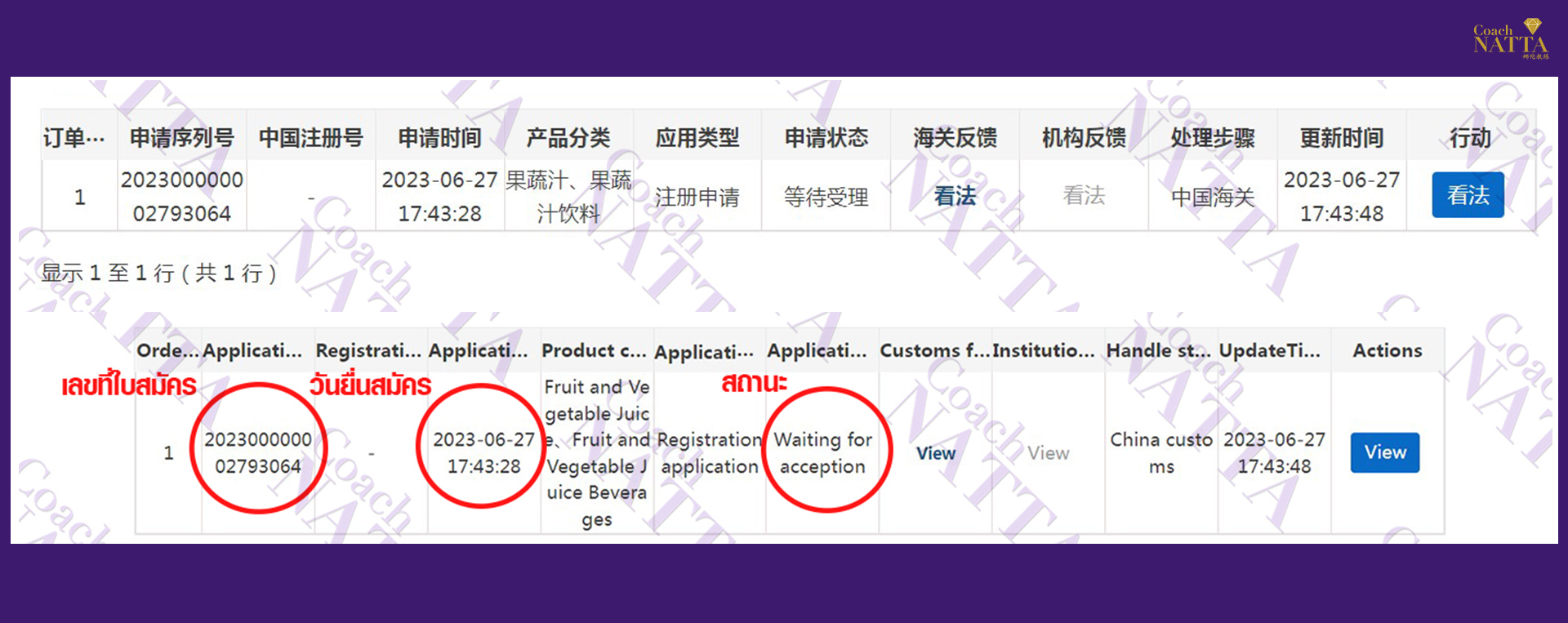 อยู่ในกระบวนการพิจารณา GACC โดย China customsวันที่ 28/06/2566 - 29/06/2566
อยู่ในกระบวนการพิจารณา GACC โดย China customsวันที่ 28/06/2566 - 29/06/2566
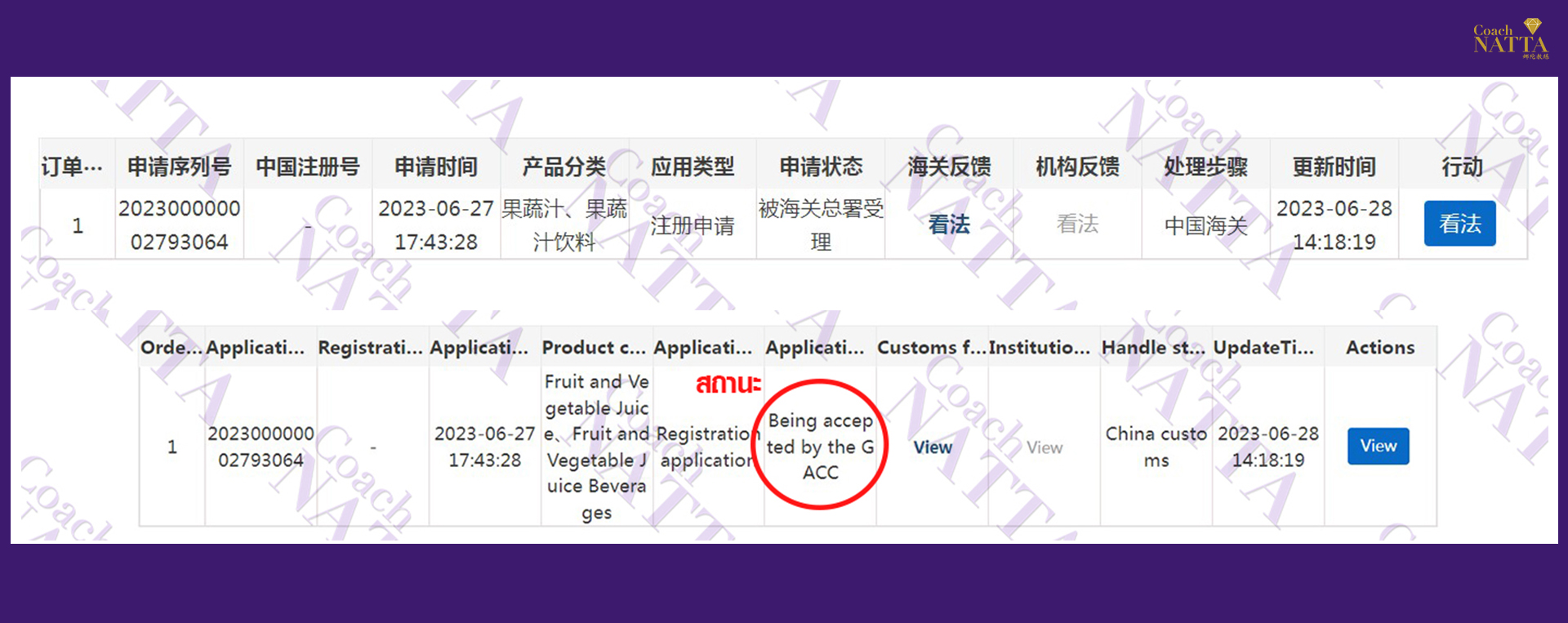
ผ่านการอนุมัติ ได้เลข GACC ในวันที่ 30/06/2566 ใช้เวลาอันรวดเร็วโดยทีมงานมืออาชีพ

ภาพตัวอย่าง การขึ้นทะเบียน GACC ที่สำเร็จแล้ว (ตัวอย่างบางส่วน)
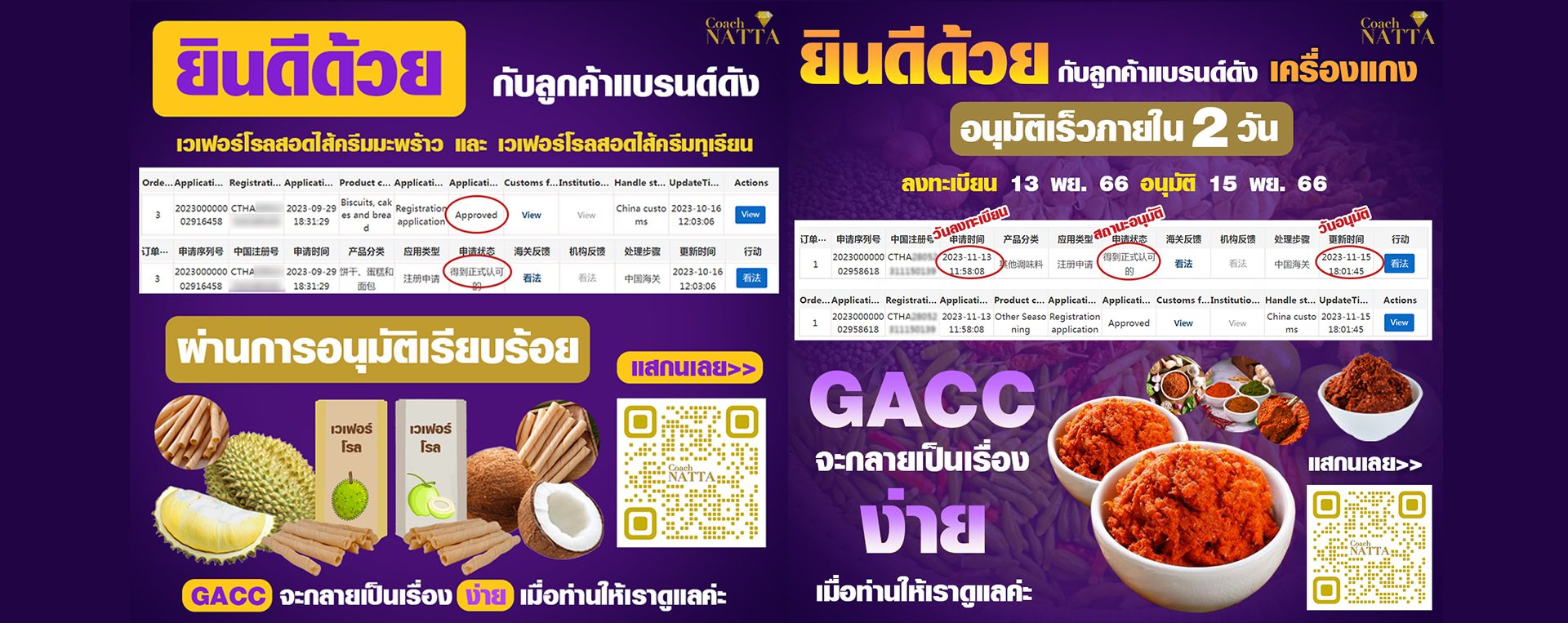
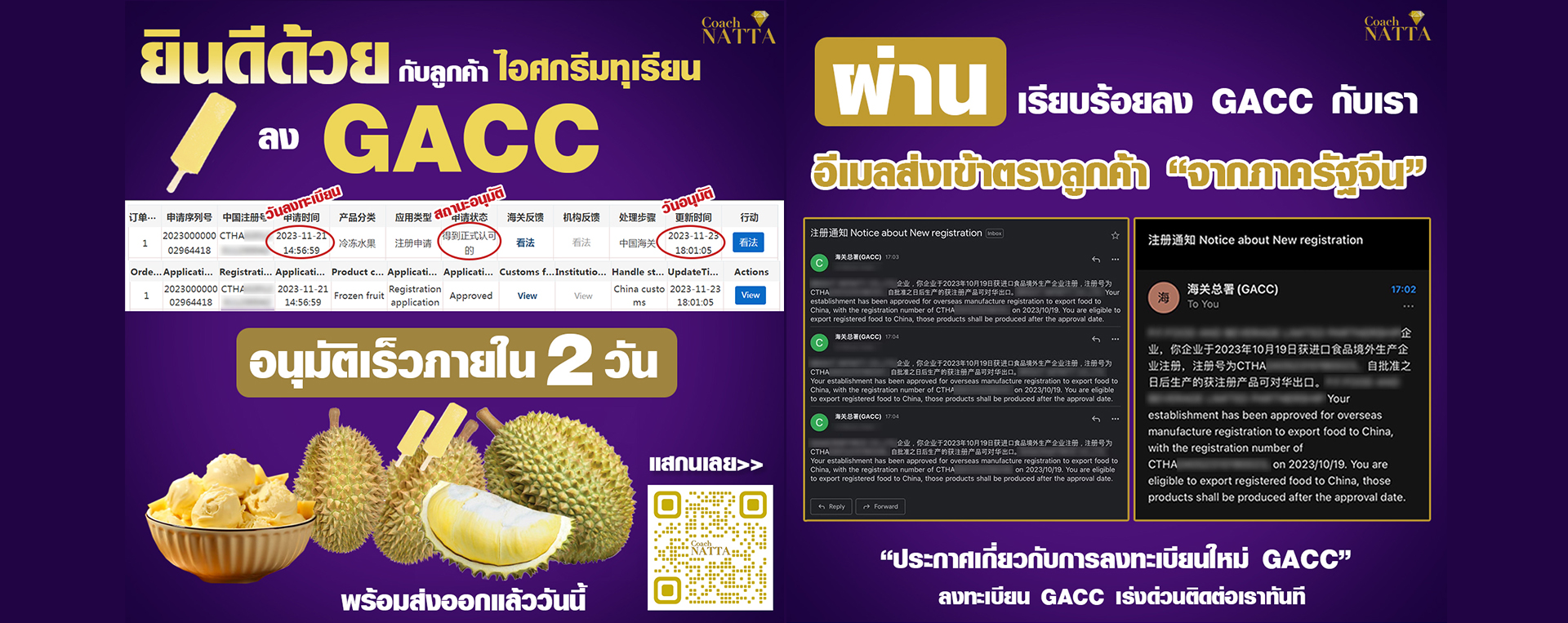
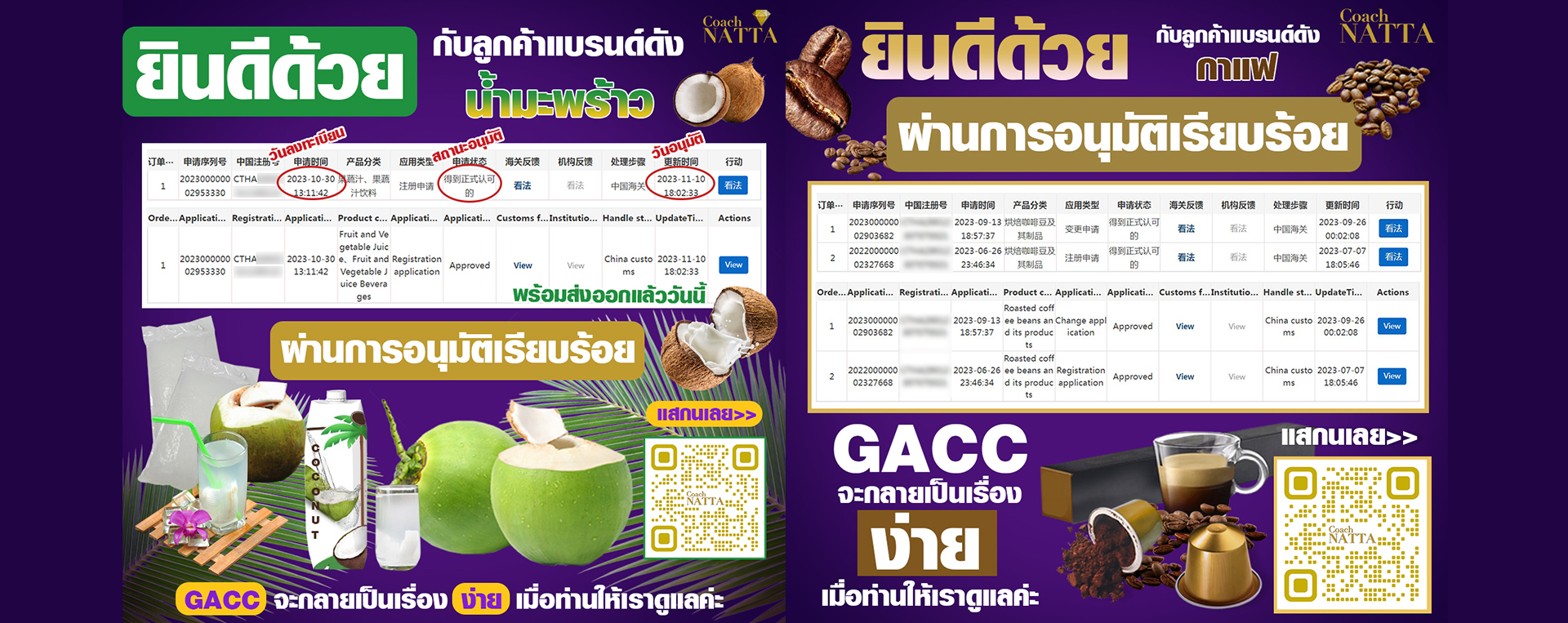
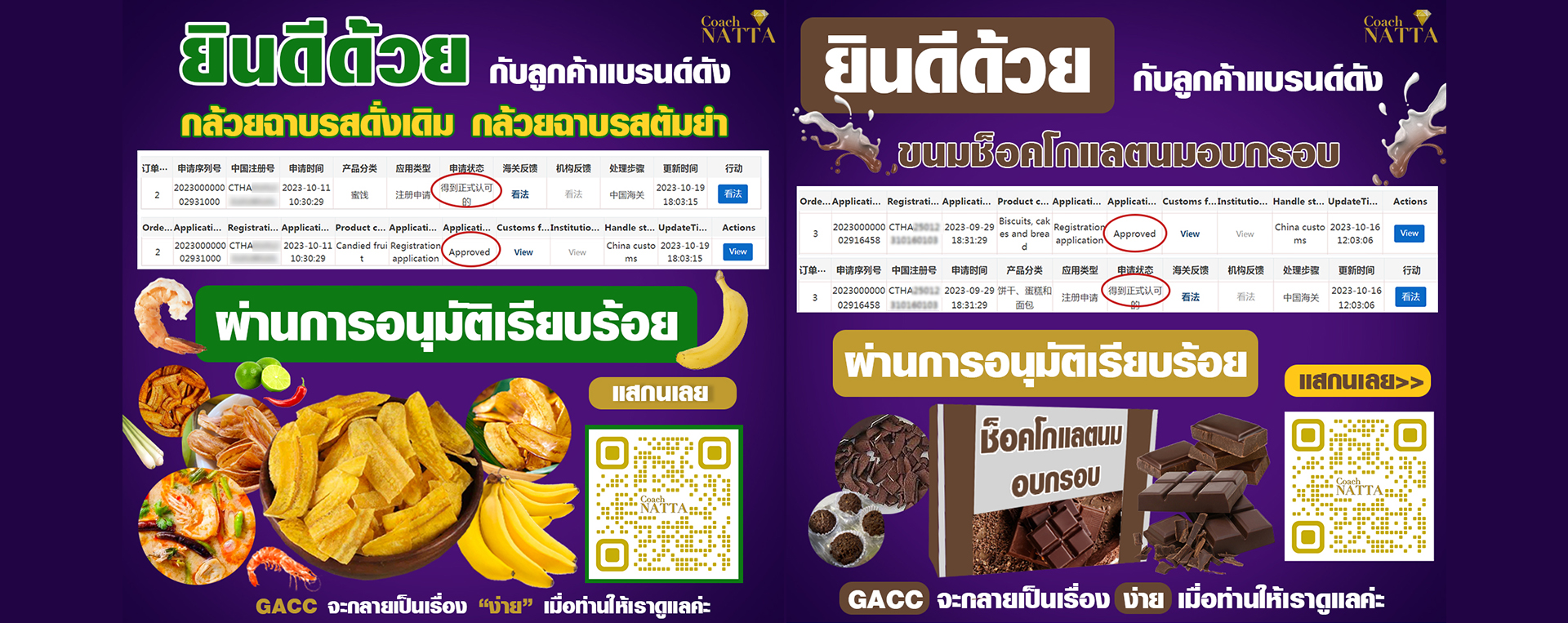
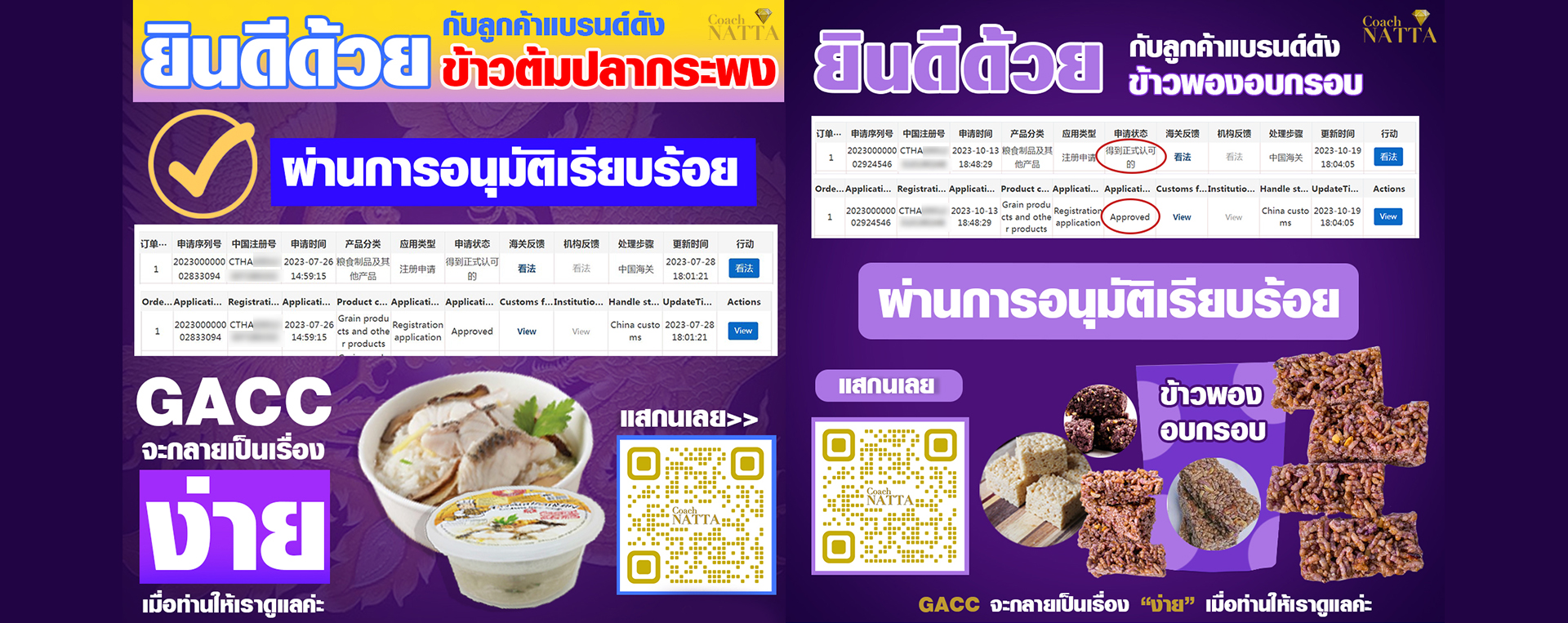
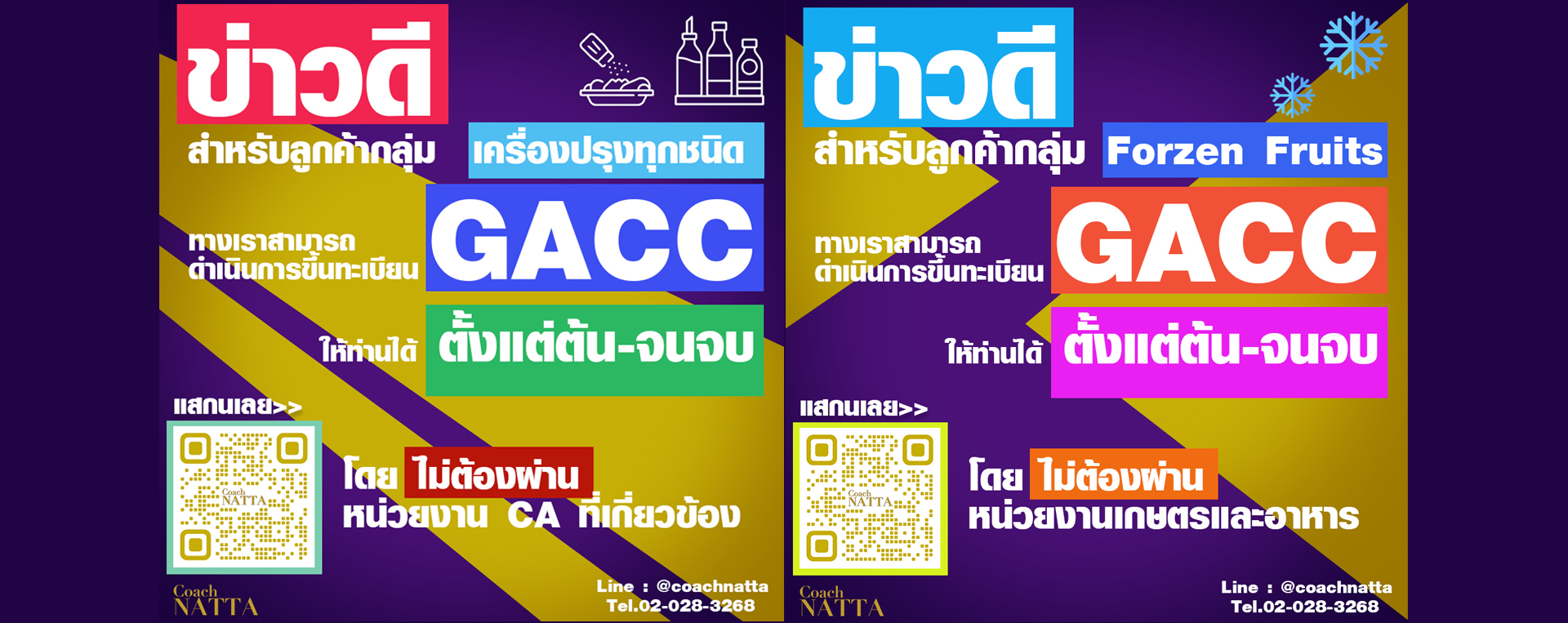
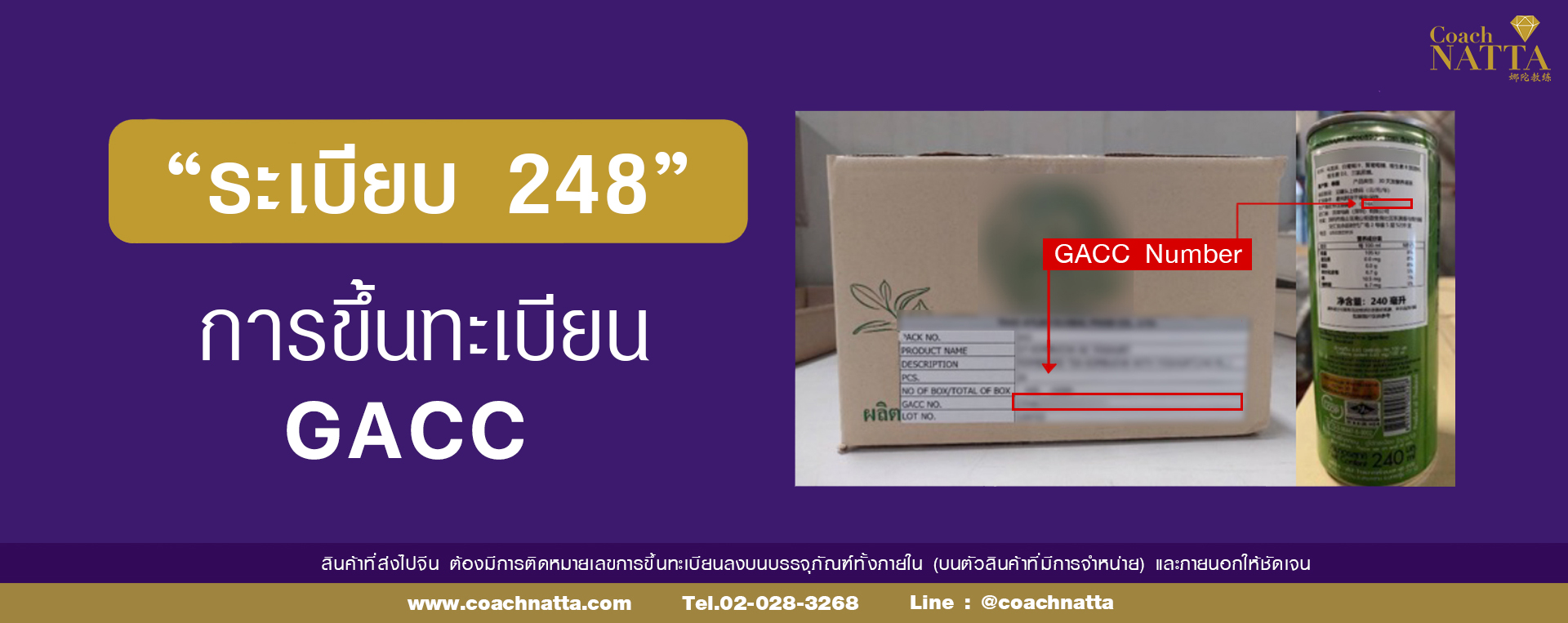
❖ ผู้ผลิตสินค้าอาหารจากต่างประเทศที่ จะส่งไปจีน ต้องมีการขึ้นทะเบียนกับ GACC และดำเนินการตามกฎระเบียบข้อบังคับด้านความปลอดภัยอาหารของจีน ก่อนที่จะมีการส่งออก
❖ สินค้าที่ส่งไปจีน ต้องมีการติดหมายเลขการขึ้นทะเบียนลงบนบรรจุภัณฑ์ทั้งภายใน (บนตัวสินค้าที่มีการจำหน่าย) และภายนอกให้ชัดเจน
*ทะเบียนจะมีอายุ 5 ปี และต้องมีการต่ออายุล่วงหน้า 3 – 6 เดือน
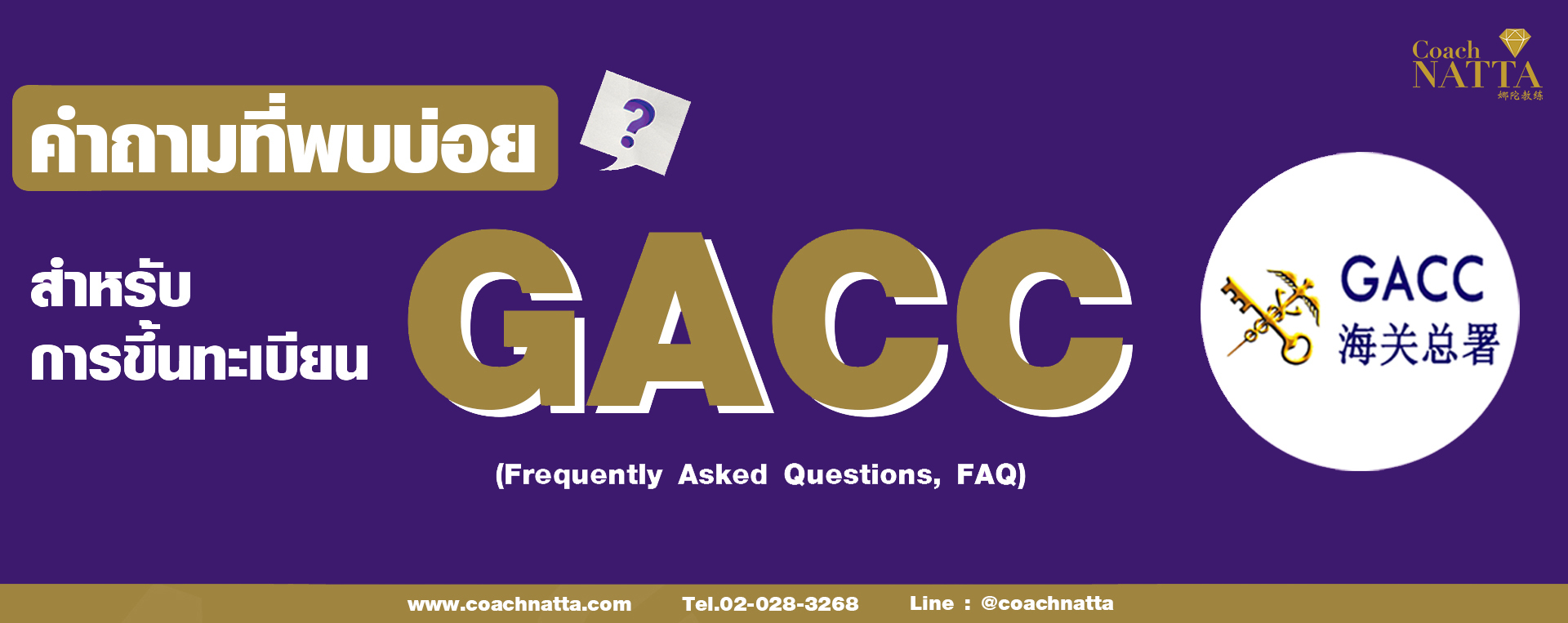
1. ระเบียบ 248 นี้ บังคับสำหรับผู้ผลิตที่ส่งไปฮ่องกง และไต้หวันหรือไม่
ตอบ ไม่ กฎระเบียบดังกล่าวครอบคลุมเฉพาะส่วนของจีนแผ่นดินใหญ่เท่านั้น
2. หากผู้ประกอบการมีโรงงานหลายสาขา ซึ่งมีสถานที่ผลิตแตกต่างกัน ควรจะขึ้นทะเบียนอย่างไร
ตอบ หากผู้ประกอบการมีโรงงานผลิตที่มีที่อยู่แตกต่างกัน มีการขึ้นทะเบียนสถานที่ผลิตต่างกัน แม้ว่าจะมีการผลิตสินค้าประเภทเดียวกัน แนะนำให้มีการขึ้นทะเบียนแยกกัน เนื่องจากโรงงานดังกล่าวอาจมีรายละเอียดอื่นที่แตกต่างกัน เช่น กำลังการผลิต มีหมายเลขทะเบียนที่ออกโดยอย. แตกต่างกัน เป็นต้น
3. ระเบียบ 249 คืออะไร มีการขึ้นทะเบียนผู้ประกอบการ แยกกันไประหว่างระเบียบ 248 และ 249 หรือไม่
ตอบ ไม่ ระเบียบ 249 หรือ มาตรการความปลอดภัยสำหรับอาหารนำเข้าและส่งออก (Administrative Measures on Import and Export Food Safety: Decree 249) ประกอบด้วย 6 บท 79 ข้อ เกี่ยวกับมาตรการหลัก ได้แก่ กระบวนการนำเข้าอาหารของจีน กระบวนการส่งออกอาหารของจีน การตรวจสอบและการบริหาร ความปลอดภัยด้านอาหารของจีน และบทลงโทษทางกฎหมาย เป็นต้น ซึ่งอาจมีการระบุรายละเอียดที่คาบเกี่ยวถึงผู้ผลิตอาหารจากต่างประเทศอยู่ด้วย
4. หากเป็นเกษตรกร และโรงคัดบรรจุที่ส่งออกผลไม้สด ต้องขึ้นทะเบียน 248 อีกหรือไม่
ตอบ ไม่ เนื่องจากกลุ่มสินค้าผลไม้สด ไม่อยู่ภายใต้ขอบข่ายที่อยู่ในระเบียบ 248 นี้ แต่ไทยและจีนได้มีการจัดทำข้อกำหนดหรือพิธีสารร่วมกันเกี่ยวกับเงื่อนไขที่เกี่ยวข้องกับการส่งออกผลไม้สดไปยังจีนต้องมีการขึ้นทะเบียนสวนและโรงคัดบรรจุจากกรมวิชาการเกษตร ก่อนจะเสนอให้ GACC พิจารณาประกาศหมายเลขทะเบียนที่ได้รับอนุญาต และมีเงื่อนไขอื่นๆ ที่เกี่ยวข้อง ซึ่งผู้ประกอบการสามารถติดต่อประสานงานไปยังกรมวิชาการเกษตรได้โดยตรง
ตอบ การติดหมายเลขทะเบียนผู้ผลิตที่ได้รับจาก GACC ถือเป็นข้อกําหนดเพิ่มเติม ผู้ประกอบการยังต้อง ดําเนินการตามกฎระเบียบที่เกี่ยวข้องกับผลิตภัณฑ์ของตน เช่น
• General Principles for the Labelling of Pre-packaged Foods (GB7718)
• Standard for Nutrition Labelling of Pre-packaged Foods. (GB28050)
• Labelling of Pre-packaged Foods for Special Dietary Uses. (GB13432)
โดยข้อมูลที่ถูกระบุอยู่ในฉลากต้องเป็นไปตามระเบียบข้อบังคับของจีน เป็นข้อมูลจริง ครบถ้วน และสอดคล้องกับ ข้อมูลที่ผู้ประกอบการกรอกลงในระบบ CIFER ซึ่งฉลากต้องแสดงให้เห็นชัดเจน ไม่ลอกเลือน โดยอาจถูกพิมพ์ลง บนสติกเกอร์หรือสกรีนลงบรรจุภัณฑ์ซึ่งต้องเป็นไปตามระเบียบของจีน
(เว้นแต่ผลิตภัณฑ์บางประเภทที่มี ข้อกําหนดเฉพาะ เช่น อาหารเสริมเพื่อสุขภาพ อาหารทารก เป็นต้น ที่ไม่สามารถใช้สติกเกอร์ได้)
